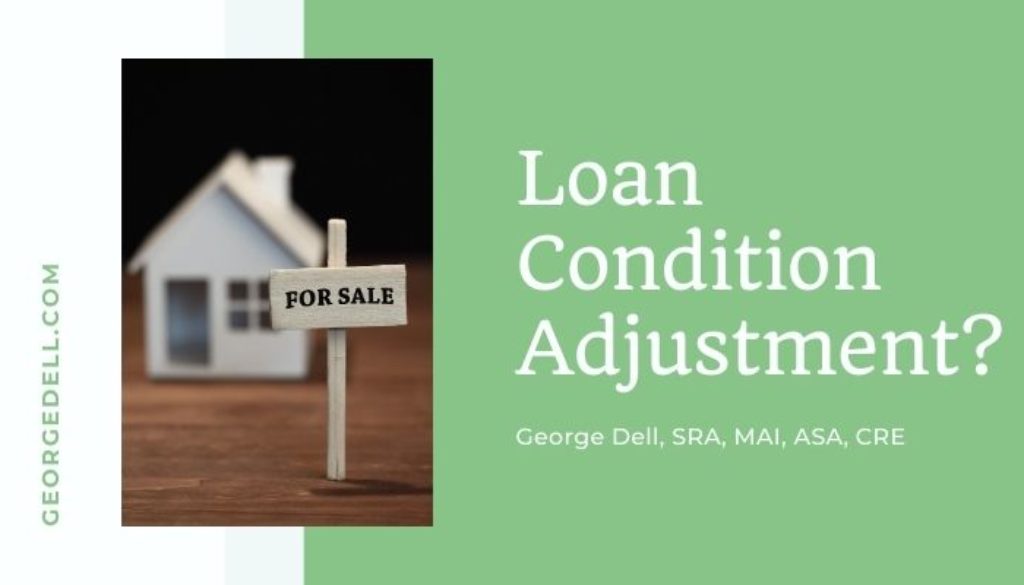Appraisers have adjustments for “market conditions” and “sale conditions.”
Why not “loan conditions?”
There are similarities and differences.
This is Part II in this series. Read Part I here Loan Conditions.
Market conditions, for any particular market, price levels – trend together. So, appraisers apply ‘time’ adjustments to compensate for this change in ‘market conditions.’
Sale conditions help comply with market value requirements. Most definitions of market value require “typical motivations of buyers and sellers.”
Typical loan conditions may be important, as three of the five ‘market value definition’ requirements relate directly to the way cash is gathered for a buy:
- Payment is made in cash, or financial terms “comparable thereto.”
- Buyer and seller are typically motivated.
- The price is “unaffected by special or creative financing.”
Let’s take a quick look at each of these three.
Payment in cash. Logically, to the seller, cash is cash, no matter whether it comes from the buyer, relatives, or a friendly bank or government agency. But to the seller, who does not have the cash – it is quite different. The cash must come from “financial arrangements comparable thereto”. The question rises up: “What is comparable to there?”
Typical motive. Again, for the seller, it is simple: more cash is better than less cash. For the buyer, it is a different story. The motive may be a place to live or use, and the promise of financial gain. This ‘financial gain’ part gets complicated. But basically, if you can get cash, borrowed cash, at a cost (interest) lower than your hoped-for gain, you win.
Let’s call this the interest/inflation gamble. If you win, you are rich. If you lose, you get a bad credit score (and possibly lose the house you did not have before anyway).
Unaffected by financing, special or creative. Again, the seller does not care where the cash comes from. The buyer’s motive is a place to live, and a way to win. The only question here is simple: What is special, and what is creative? And what is “normal or typical”?
So, there we have it. Market conditions consider the change in the whole market. Sale conditions consider the whole typical market. Should loan conditions also consider the whole typical market?
It appears that true ‘loan conditions’ compliance with current typical definitions of market value would require resolution of the following issues:
- What is ‘normal’ in cash-equivalency for collateral loans?
- What is ‘normal’ motive for a house + interest/inflation gamble?
- What is ‘normal or typical’ for borrowed cash to be equivalent to my cash?
Hmmm. These questions seem to raise questions. We have discussed “appraisal modernization” and current FHFA initiatives. Is it possible these questions go to the root of our problems?

March 11, 2021 @ 6:42 am
I had a case that involved hundreds of appraisals prepared during the boom years, across Southern California. Prevalent at the time was 100% financing, stimulating irrational behavior and contributing to rapidly escalating prices.
The reports were authored by dozens and dozens of different appraisers, all independent. Or, rather, dependent on lender work.
Universally the sales were 100% financed, often with 80/20 loans. Often the appraiser reported the 80% loan amount, but universally omitted the 20% second, which showed up in the same public record data source.
Our job was to review the reports as written, often resulting in adjustments that were omitted in the original reports, or given token adjustments for what were major factors, such as Location, Remodeling, Pools/Spas, etc.
Universally, the appraisals were not objective unbiased, but were written in favor of hitting the sales prices that were being artificially created with 100% financing and no qualifier loans.
If was quite apparent that the appraisers had no concept of neutrality, or the public good. Was this a universal problem. or rather, is it and does it continue to be one? I think so, especially at the loan production level.
No Time for Time Adjustment? - George Dell, SRA, MAI, ASA, CRE
April 12, 2023 @ 3:44 pm
[…] property, it will reflect an inappropriate time period, and will usually reflect differing sale conditions, or even property condition (a […]